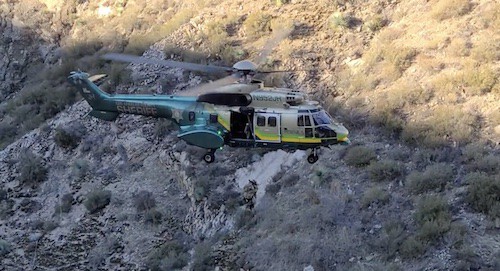Last Updated on March 16, 2023

When it comes to life-saving technologies that seniors can use to call for help, we often think of a medical alert device. While that is effective in many situations, it’s good to know what newer technologies like the Apple iPhone’s Emergency SOS service can do.
With the update of the iPhone 14 Emergency SOS feature in Nov 2022, we now have a smartphone that can send SOS emergency messaging using satellite communications. If you live in or travel into an area with limited cellular coverage, you could still rely on the iPhone 14 to alert for help using satellite services.
Here’s what happened to one couple…
Apple Emergency SOS saved the day
In Dec 2022, barely a month after the introduction of satellite emergency messaging, a couple experienced the feature in action. The Glendale, California couple’s car fell 300 feet down a steep slope with them inside.
They miraculously survived their fall off the Los Angeles Forest Highway with mild injuries. Their biggest obstacle was being stranded in a remote area called Monkey Canyon.
Fortunately, when the accident happened, the phone’s Crash detection feature kicked in. The iPhone automatically sent an alert to a dispatch or monitoring center via satellite. Since the couple was physically fine, they were able to communicate further with the emergency operator through Emergency SOS via Satellite text messaging.
If the same car accident had happened a month earlier, before the Apple iPhone 14 with Satellite SOS feature became available, their situation could have grown dire. Their remote location made it unlikely that their iPhone could call 911 for help.

How Apple’s Emergency SOS Via Satellite Works
According to Apple, here’s how their Crash Detection and Emergency SOS via Satellite works:
If your iPhone or Apple Watch detects a severe car crash or a hard fall and you’re unresponsive, an automatic Crash Detection or Fall Detection notification to emergency services may be communicated by your iPhone 14 or iPhone 14 Pro using Emergency SOS via satellite if you’re outside of cellular and Wi-Fi coverage.
Automatic Crash Detection
If the user has taken a hard fall and loses consciousness or experiences an extreme auto accident, if their iPhone or Apple Watch senses it, the system can send an automatic alert to the appropriate parties.
Their automatic detection feature would work if the user has lost consciousness or the phone has been thrown far from the user.
Satellite connection also ensures that those in an emergency can stay in contact with emergency specialists even if their cell connectivity is unreliable.
For Seniors Using Medical Alert Systems
Sometimes, seniors may live in spaces with unreliable cell coverage, such as rural areas or places off the grid. This iPhone feature can alert emergency services and loved ones even if cellular service in the area fails.
However, there is a catch. The satellite connection works best in an open space.
If you are inside the house, the roof may impede your connectivity.
What they could do is rely on an in-home medical alert system that is always connected using a landline. Most in-home medical alert systems also come with optional fall detection buttons.
If they are out and about a lot, their iPhone could be something that they could use on-the-go.
As long as the area is not covered up or surrounded by dense foliage, the connection should be strong enough to access the services.
How much does the Apple Emergency SOS via Satellite service cost?
For the first two years after activating an iPhone 14 or iPhone 14 Pro, users can utilize the Emergency SOS via satellite free of charge. After that, there may be fees or other costs associated with the service.
An iPhone 14 retails for $799 and up. The monthly subscription cost will depend on your cellular phone provider’s plans.
Until new releases are made, Emergency SOS via Satellite is only available with iPhone 14 and iPhone 14 Plus models. The feature is not available with any Apple Watch models yet.
In a hurry? Leave us your email, we’ll follow-up with the best tips.

